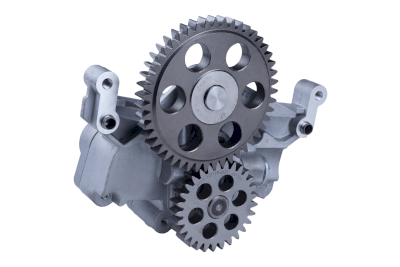What Is a Gear Pump ?

Gear Pumps are used to pump oil and other fluids by utilizing the meshing parts of gears (cogwheels).
A fixed amount of fluid is discharged per gear revolution. The discharge rate does not change much as the pressure rises, and the pump features good metering performance.
When used, the shaft end (shaft) of the Gear Pump is connected to a prime mover such as an engine or electric motor. The power of the prime mover drives the gears to push the fluid out.
One feature of the Gear Pump that is not found in other rotary positive displacement pumps is the structural advantage of being able to switch between forward and reverse rotation to change the suction and discharge directions. Some products can switch between forward and reverse rotation, which is useful when switching directions when transferring fluids.
Applications of Gear Pumps
Pump Gears are widely used in industry.
They are used in equipment with hydraulic systems, such as hydraulic excavators, forklifts, and agricultural machinery. Liquids to be pumped include oils, resins, paints, adhesives, and solvents.
Since there are few points of contact other than the gear and casing, and disassembly is relatively easy, they are also used in the chemical, food, and pharmaceutical industries. They can also be used for liquids containing a certain amount of solids.
Principle of Gear Pump
A Gear Pump consists of gears, casing, discharge and suction ports, and seals.
The gear consists of an internal gear and an external gear. The pump construction differs depending on the mounting point and number of gears. Liquid entering through the suction port is pressurized by the gears and casing and is discharged through the discharge port.
Oil seals or mechanical seals are used to seal the shaft of the Gear Pump. An oil seal uses the seal’s own elasticity to ensure a tight seal, while a mechanical seal uses the force of a coil spring to ensure a tight seal.
In general, mechanical seals have fewer leaks and are easier to maintain. However, maintenance frequency and equipment life can be improved by designing in consideration of the fluid type, pump specifications, and operating conditions. In addition, periodic checks are necessary to ensure that proper clearances are maintained and that there are no changes in leakage.
Types of Gear Pumps
A Gear Pump is a mechanism that pumps liquid through a gap between gears, and these pumps that sequentially pump a fixed volume are called positive displacement pumps. Gear Pump is a type of rotary positive displacement pump, and similar rotary positive displacement pumps include vane pumps and screw pumps. In a broad sense, rotary pumps are a generic term for all rotary positive displacement pumps. As such Gear Pumps can also be called a type of rotary pump.
In practice, the designation differs depending on the application. In particular, oil rotary pumps for vacuuming are often called rotary pumps. The mechanism of oil rotary vacuum pumps can be of the vane type, cam type, or oscillating piston type.
In addition, there are two types of Gear Pumps: circumscribed gear type and internal gear type.
1. Circumscribed Gear Pump
Two external gears are mounted next to each other inside the pump. When a prime mover such as an engine or an electric motor operates, the shaft of the pump rotates to take in fluid from the pump suction port.
In this type of pump, a small gap is created when the adjacent gears rotate. The gap is filled with fluid, which flows along the inner circumference of the pump and finally flows from the discharge port.
2. Internal Gear Pump
One internal gear and one external gear are mounted inside the casing inside the pump. The internal contact type consists of an internal gear and an external gear with one less tooth. When the external gear is rotated by the drive shaft, the external gear rotates along with the internal gear. This rotation pushes the fluid out through the discharge port.
Other Information on Gear Pumps
Maintenance of Gear Pumps
There are various causes of gear pump failure, but cavitation and air biting are the most common.
Cavitation is a phenomenon that occurs when a partial pressure difference occurs in the casing and the pressure drops to the saturated vapor pressure of the liquid, and is one of the causes of insufficient gear pump discharge pressure. When this phenomenon occurs, a large impact pressure is generated at the time of bubble extinction. This impact pressure causes abnormal noise, and if it continues, vibration will occur, causing failure.
Countermeasures against cavitation include enlarging the pipe inner diameter, shortening the suction side piping, and making the pump suction conditions as push-in as possible. These should be considered at the equipment design stage.
Air bite is a phenomenon in which air is sucked into the pump, causing air to accumulate inside, leading to a decrease in discharge pressure and flow rate. Countermeasures include installing the pump below the fluid level, reducing the number of bends in the piping, and avoiding downward sloping piping. Care should be taken when changing the layout of equipment.